Related Research Articles
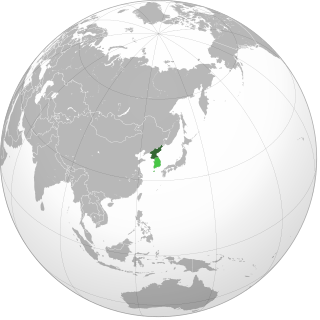
North Korea has a military nuclear weapons program and, as of early 2020, is estimated to have an arsenal of approximately 30 to 40 nuclear weapons and sufficient production of fissile material for six to seven nuclear weapons per year. North Korea has also stockpiled a significant quantity of chemical and biological weapons. In 2003, North Korea withdrew from the Treaty on the Non-Proliferation of Nuclear Weapons (NPT). Since 2006, the country has conducted six nuclear tests at increasing levels of expertise, prompting the imposition of sanctions.

Iran and the United States have had no formal diplomatic relations since 7 April 1980. Instead, Pakistan serves as Iran's protecting power in the United States, while Switzerland serves as the United States' protecting power in Iran. Contacts are carried out through the Iranian Interests Section of the Pakistani Embassy in Washington, D.C., and the US Interests Section of the Swiss Embassy in Tehran. In August 2018, Supreme Leader of Iran Ali Khamenei banned direct talks with the United States.

A medium-range ballistic missile (MRBM) is a type of ballistic missile with medium range, this last classification depending on the standards of certain organizations. Within the U.S. Department of Defense, a medium-range missile is defined by having a maximum range of between 1,000 and 3,000 kilometres. In modern terminology, MRBMs are part of the wider grouping of theatre ballistic missiles, which includes any ballistic missile with a range of less than 3,500 kilometres (2,200 mi).

Iran is not known to currently possess weapons of mass destruction (WMD) and has signed treaties repudiating the possession of WMDs including the Biological Weapons Convention, the Chemical Weapons Convention, and the Non-Proliferation Treaty (NPT). Iran has first-hand knowledge of WMD effects—over 100,000 Iranian troops and civilians were victims of chemical weapons during the 1980s Iran–Iraq War.

The Islamic Revolutionary Guard Corps Aerospace Force or Islamic Revolutionary Guard Corps Air and Space Force is the strategic missile, air, and space force within the Islamic Revolutionary Guard Corps (IRGC) of Iran. It was renamed from the IRGC Air Force into the IRGC Aerospace Force in 2009.

The Ghadr-110 or Qadr-110, is a medium-range ballistic missile designed and developed by Iran. The missile has a range of 1,800 km to 2,000 km. The Iranian Armed Forces first displayed the missile to the public at an annual military parade to mark the Iran–Iraq War.
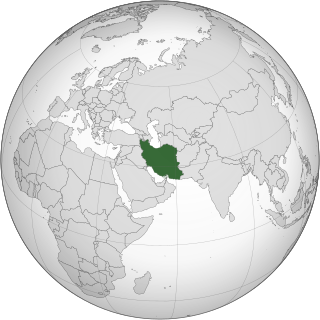
United Nations Security Council Resolution 1737 was unanimously passed by the United Nations Security Council on 23 December 2006.

Since the Iranian Revolution in 1979, the Islamic Republic of Iran has been embroiled in tense relations with the U.S. and its allies. Following the overthrow of the American-backed Shah and a hostage crisis, both countries severed relations. Since then, both countries have been involved in numerous direct confrontations, diplomatic incidents, and proxy wars throughout the Middle East, which has caused the tense nature of the relationship between the two to be called an 'international crisis'. Both countries have often accused each other of breaking international law on several occasions. The U.S. has often accused Iran of sponsoring terrorism and of illegally maintaining a nuclear program, as well as using strong rhetoric against Israel, of which Iran has questioned its legitimacy and its right to exist while supporting Hamas, an antizionist group in the Gaza Strip. Meanwhile, Iran has often accused the U.S. of human rights violations and of meddling in their affairs, especially within the Iranian Democracy Movement.
The Hwasong-10, also known by the names BM-25 and Musudan, is a mobile intermediate-range ballistic missile developed by North Korea. Hwasong-10 was first revealed to the international community in a military parade on 10 October 2010 celebrating the Workers' Party of Korea's 65th anniversary, although experts believe these were mock-ups of the missile. Hwasong-10 resembles the shape of the Soviet Union's R-27 Zyb submarine-launched missile, but is slightly longer. It is based on the R-27, which uses a 4D10 engine propelled by unsymmetrical dimethylhydrazine (UDMH) and nitrogen tetroxide (NTO). These propellants are much more advanced than the kerosene compounds used in North Korea's Scuds and Nodong missiles.
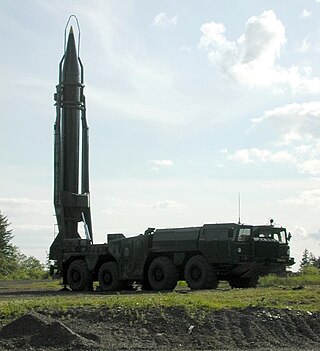
A Scud missile is one of a series of tactical ballistic missiles developed by the Soviet Union during the Cold War. It was exported widely to both Second and Third World countries. The term comes from the NATO reporting name attached to the missile by Western intelligence agencies. The Russian names for the missile are the R-11, and the R-17Elbrus. The name Scud has been widely used to refer to these missiles and the wide variety of derivative variants developed in other countries based on the Soviet design.

The P5+1 refers to the UN Security Council's five permanent members ; namely China, France, Russia, the United Kingdom, and the United States; plus Germany. The P5+1 is often referred to as the E3+3 by European countries. It is a group of six world powers which, in 2006, joined together in diplomatic efforts with Iran with regard to its nuclear program.
There have been a number of international sanctions against Iran imposed by a number of countries, especially the United States, and international entities. Iran was the most sanctioned country in the world until it was surpassed by Russia, following Russia's invasion of neighboring Ukraine in February 2022.

United Nations Security Council Resolution 1929, adopted on 9 June 2010, after recalling resolutions 1696 (2006), 1737 (2006), 1747 (2007), 1803 (2008), 1835 (2008) and 1887 (2009) concerning the topics of Iran and non-proliferation, the Council noted that Iran had failed to comply with previous Security Council resolutions concerning its nuclear program and imposed further sanctions on the country.
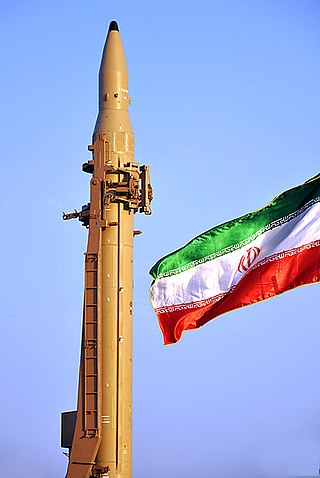
The Qiam 1 is a short-range ballistic missile designed and built by Iran. It was developed from the Iranian Shahab-2, a licensed copy of the North Korean Hwasong-6, all of which are versions of the Soviet Scud-C missile. The Qiam 1 entered service in 2010, with a range of 800 km (500 mi) and 100 m (330 ft) (CEP) accuracy.

The Joint Comprehensive Plan of Action, commonly known as the Iran nuclear deal or Iran deal, is an agreement on the Iranian nuclear program reached in Vienna on 14 July 2015, between Iran and the P5+1 together with the European Union.

United Nations Security Council Resolution 2231 was a 20 July 2015 resolution endorsing the Joint Comprehensive Plan of Action on the nuclear program of Iran. It sets out an inspection process and schedule while also preparing for the removal of United Nations sanctions against Iran. The 15 nations on the Security Council unanimously endorsed the resolution, which had been negotiated by the permanent members of the United Nations Security Council—China, France, Russia, the United Kingdom, and the United States—plus Germany, the European Union, and Iran.
A number of countries and international bodies have imposed international sanctions against North Korea. Currently, many sanctions are concerned with North Korea's nuclear weapons program and were imposed after its first nuclear test in 2006.
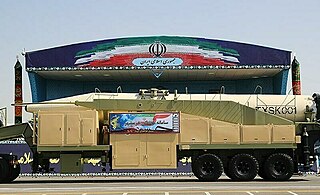
The Khorramshahr, named after the city of Khorramshahr in Iran, is a medium-range ballistic missile that was tested by Iran in January 2017. Its range is between 1,000–2000 km with a 1,800 kg warhead and is 13 m in length.

The Joint Comprehensive Plan of Action, commonly known as the Iran nuclear deal or Iran deal, is an agreement on the Iranian nuclear program reached in Vienna on 14 July 2015 between Iran, the P5+1, and the European Union.
Iran has provided Russia with loitering munitions for use in the latter's invasion of Ukraine, chiefly the Shahed 131 and Shahed 136. Several countries have accused Iran of violating the United Nations Security Council Resolution 2231.
References
- ↑ Resolution 1929 (2010)
- ↑ U.S. preparing sanctions on Iran over ballistic missile program: sources
- ↑ "Iran sends defiant signal to the West with missile test". The Daily Telegraph . Dec 9, 2015.
- ↑ Iran tests ballistic missile in defiance of UN resolution, US officials say
- ↑ "Iran tests new ballistic missile hours after showing it off at military parade". CNN . 23 September 2017.
- ↑ "New developments in Iran's ballistic missile program". Israel Hayom. Mar 15, 2019.
- ↑ "New developments in Iran's ballistic missile program". Israel Hayom. Mar 15, 2019.
- ↑ "New developments in Iran's ballistic missile program". Israel Hayom. Mar 15, 2019.
- ↑ "Europe is 'saving' the Iran deal by ignoring the violations". New York Times. Dec 6, 2018.
- ↑ "New developments in Iran's ballistic missile program". Israel Hayom. Mar 15, 2019.
- ↑ "New developments in Iran's ballistic missile program". Israel Hayom. Mar 15, 2019.
- ↑ "Iran unveils new ballistic missile at underground facility". Deutsche Welle. Feb 8, 2019.
- ↑ "New developments in Iran's ballistic missile program". Israel Hayom. Mar 15, 2019.
- ↑ "US asks UN Security Council to meet on 'destabilizing' Iran missile tests". i24news. Mar 12, 2016.
- ↑ "پیام موشکی سپاه به زبان "عبری" مخابره شد: ישראל צריכה להימחק מעל+تصویر". Fars News Agency. Mar 10, 2016. Archived from the original on March 10, 2016.
- ↑ Israel Radio, March 10, 2016.
- ↑ "Iran 'conducts new ballistic missile tests'". BBC. Mar 8, 2016.
- ↑ "Iran missile tests defied UN resolution, say US and European allies". Deutsche Welle. Mar 30, 2016.
- ↑ Statement by National Security Advisor Michael T. Flynn on Iran
- ↑ Treasury Sanctions Supporters of Iran’s Ballistic Missile Program and Iran’s Islamic Revolutionary Guard Corps – Qods Force
- ↑ "Trump administration tightens Iran sanctions, Tehran hits back". Reuters. 3 February 2016.